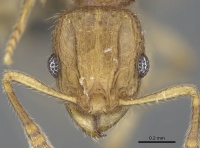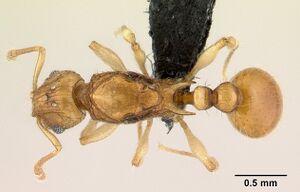Vitsika tenuis
| Vitsika tenuis | |
|---|---|

| |
| Scientific classification | |
| Kingdom: | Animalia |
| Phylum: | Arthropoda |
| Class: | Insecta |
| Order: | Hymenoptera |
| Family: | Formicidae |
| Subfamily: | Myrmicinae |
| Tribe: | Crematogastrini |
| Genus: | Vitsika |
| Species: | V. tenuis |
| Binomial name | |
| Vitsika tenuis Bolton & Fisher, 2014 | |
All material of this species was retrieved from litter samples in rainforest.
Identification
Bolton and Fisher (2014) - The vast majority of tenuis specimens are instantly recognisable by their strongly downcurved propodeal spines. Some other species have propodeal spines that in profile are shallowly curved or weakly sinuate, but none are downcurved to the extent seen in tenuis. In addition, tenuis is a small yellow species (HW 0.46–0.52), with relatively few ommatidia in the eye, without a marked peak or crest in the propodeal dorsal outline, with an upright petiole node that lacks strong sculpture, and with the disc of the postpetiole smooth.
Keys including this Species
Distribution
Endemic to Madagascar.
Latitudinal Distribution Pattern
Latitudinal Range: -13.8° to -13.8°.
| North Temperate |
North Subtropical |
Tropical | South Subtropical |
South Temperate |
- Source: AntMaps
Distribution based on Regional Taxon Lists
Malagasy Region: Madagascar (type locality).
Distribution based on AntMaps
Distribution based on AntWeb specimens
Check data from AntWeb
Countries Occupied
| Number of countries occupied by this species based on AntWiki Regional Taxon Lists. In general, fewer countries occupied indicates a narrower range, while more countries indicates a more widespread species. |

|
Estimated Abundance
| Relative abundance based on number of AntMaps records per species (this species within the purple bar). Fewer records (to the left) indicates a less abundant/encountered species while more records (to the right) indicates more abundant/encountered species. |

|
Biology
Castes
Males have yet to be collected.
Worker
Images from AntWeb
   
| |
| Worker. Specimen code casent0464913. Photographer Erin Prado, uploaded by California Academy of Sciences. | Owned by CAS, San Francisco, CA, USA. |
Queen
Images from AntWeb
   
| |
| Paratype of Vitsika tenuis. Queen (alate/dealate). Specimen code casent0464934. Photographer Erin Prado, uploaded by California Academy of Sciences. | Owned by CAS, San Francisco, CA, USA. |
Nomenclature
The following information is derived from Barry Bolton's Online Catalogue of the Ants of the World.
- tenuis. Vitsika tenuis Bolton & Fisher, 2014: 92, figs. 117-119, Map 161 (w.q.) MADAGASCAR.
Unless otherwise noted the text for the remainder of this section is reported from the publication that includes the original description.
Description
Worker
TL 2.2–2.8 (2.7), HL 0.54–0.62 (0.61), HW 0.46–0.52 (0.50), CI 81–86 (82), SL 0.38–0.44 (0.44), SI 80–88 (88), PW 0.34–0.39 (0.39), WL 0.62–0.74 (0.74) (15 measured).
Eye with 5–6 rows of ommatidia, and with 6–7 ommatidia in the longest row; EL 0.13–0.14 (EL/HW 0.28–0.30). MfL 0.45–0.52 (MfL/HW 0.98–1.00). Dorsal outline of propodeum in profile, from approximate site of metanotal groove to dorsal base of spine, evenly curved or at most with a very low, obtuse angle anteriorly. Propodeal spines in profile usually distinctly downcurved along their length. Degree of curvature of the spines is variable: in most it is striking but in a few it is not as pronounced, and in the very smallest workers it may not be apparent. Diameter of annulus of propodeal spiracle is about equal to the thickness of the propodeal spine at its midlength. Petiole node in profile small, more or less erect with respect to the peduncle, the node not obviously inclined posteriorly; narrowly but bluntly rounded dorsally, and with the anterior and posterior faces converging toward the dorsum. Sculpture of petiole node faint to vestigial laterally, absent from posterior surface. Height of petiole node in posterior view (from midpoint of the dorsal margin of the foramen to the apex) 0.86–0.95 × its maximum width. In dorsal view postpetiole 1.20–1.38 × broader than long; maximum width of postpetiole 0.93–1.15 × the length of a propodeal spine; maximum width of postpetiole 0.82–0.92 × the distance between the apices of the propodeal spines. Length of postpetiole node in profile slightly less than the height of the segment. Disc of postpetiole entirely smooth. Full adult colour yellow.
Queen
(gyne). Only alates known. HL 0.63–0.66, HW 0.54–0.59, CI 86–89, SL 0.44–0.46, SI 79–82, PW 0.49–0.54, WL 0.90–0.96, maximum width of mesoscutum 0.43–0.50, maximum length of mesoscutum 0.44–0.52, MfL 0.54–0.60 (3 measured). Propodeal spines stouter and relatively a little shorter than in workers, but characteristically downcurved along their length.
Type Material
Holotype worker, Madagascar: Prov. Antsiranana, Ampasindava, Ambilanivy, 3.9 km. 181° S Ambaliha, 600 m., 13°48’S, 48°10’E, 4–9.iii.2001, sifted litter, rainforest, BLF 3252(33), CASENT0464860 (Fisher et al.) (California Academy of Sciences). Paratypes. 5 workers and 3 dealate queens, all BLF 3252: workers (31) CASENT0464846, (32) CASENT0464854, two numbered (42) CASENT0484907 and CASENT0464909, and (45) CASENT0464926; queens (32) CASENT0464853, (43) CASENT0464916, and (47) CASENT0464934 (California Academy of Sciences). [The eight paratype specimens have been selected from leaf litter series BLF 3252, which also contains another 14 workers and 5 dealate queens, all in CASC.]
References
- Bolton, B. & Fisher, B.L. 2014. The Madagascan endemic myrmicine ants related to Eutetramorium (Hymenoptera: Formicidae): taxonomy of the genera Eutetramorium Emery, Malagidris nom. n., Myrmisaraka gen. n., Royidris gen. n., and Vitsika gen. n. Zootaxa 3791, 1–99.
References based on Global Ant Biodiversity Informatics
- Bolton B., and B. L. Fisher. 2014. The Madagascan endemic myrmicine ants related to Eutetramorium (Hymenoptera: Formicidae): taxonomy of the genera Eutetramorium Emery, Malagidris nom. n., Myrmisaraka gen. n., Royidris gen. n., and Vitsika gen. n. Zootaxa 3791(1): 1-99.

